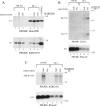De novo protein synthesis is required for lytic cycle reactivation of Epstein-Barr virus, but not Kaposi's sarcoma-associated herpesvirus, in response to histone deacetylase inhibitors and protein kinase C agonists
- PMID: 17596302
- PMCID: PMC1951462
- DOI: 10.1128/JVI.00982-07
De novo protein synthesis is required for lytic cycle reactivation of Epstein-Barr virus, but not Kaposi's sarcoma-associated herpesvirus, in response to histone deacetylase inhibitors and protein kinase C agonists
Abstract
The oncogenic human gammaherpesviruses, Epstein-Barr virus (EBV) and Kaposi's sarcoma-associated herpesvirus (KSHV), are latent in cultured lymphoma cells. We asked whether reactivation from latency of either virus requires de novo protein synthesis. Using Northern blotting and quantitative reverse transcriptase PCR, we measured the kinetics of expression of the lytic cycle activator genes and determined whether abundance of mRNAs encoding these genes from either virus was reduced by treatment with cycloheximide (CHX), an inhibitor of protein synthesis. CHX blocked expression of mRNAs of EBV BZLF1 and BRLF1, the two EBV lytic cycle activator genes, when HH514-16 Burkitt lymphoma cells were treated with histone deacetylase (HDAC) inhibitors, sodium butyrate or trichostatin A, or a DNA methyltransferase inhibitor, 5-Aza-2'-deoxycytidine. CHX also inhibited EBV lytic cycle activation in B95-8 marmoset lymphoblastoid cells by phorbol ester phorbol-12-myristate-13-acetate (TPA). EBV lytic cycle induction became resistant to CHX between 4 and 6 h after application of the inducing stimulus. KSHV lytic cycle activation, as assessed by ORF50 mRNA expression, was rapidly induced by the HDAC inhibitors, sodium butyrate and trichostatin A, in HH-B2 primary effusion lymphoma cells. In HH-B2 cells, CHX did not inhibit, but enhanced, expression of the KSHV lytic cycle activator gene, ORF50. In BC-1, a primary effusion lymphoma cell line that is dually infected with EBV and KSHV, CHX blocked EBV BRLF1 lytic gene expression induced by TPA and sodium butyrate; KSHV ORF50 mRNA induced simultaneously in the same cells by the same inducing stimuli was resistant to CHX. The experiments show, for the cell lines and inducing agents studied, that the EBV BZLF1 and BRLF1 genes do not behave with "immediate-early" kinetics upon reactivation from latency. KSHV ORF50 is a true "immediate-early" gene. Our results indicate that the mechanism by which HDAC inhibitors and TPA induce lytic cycle gene expression of the two viruses differs and suggest that EBV but not KSHV requires one or more proteins to be newly synthesized between 4 and 6 h after application of an inducing stimulus.
Figures










Similar articles
-
Histone hyperacetylation occurs on promoters of lytic cycle regulatory genes in Epstein-Barr virus-infected cell lines which are refractory to disruption of latency by histone deacetylase inhibitors.J Virol. 2008 May;82(10):4706-19. doi: 10.1128/JVI.00116-08. Epub 2008 Mar 12. J Virol. 2008. PMID: 18337569 Free PMC article.
-
Activation and repression of Epstein-Barr Virus and Kaposi's sarcoma-associated herpesvirus lytic cycles by short- and medium-chain fatty acids.J Virol. 2014 Jul;88(14):8028-44. doi: 10.1128/JVI.00722-14. Epub 2014 May 7. J Virol. 2014. PMID: 24807711 Free PMC article.
-
Protein kinase C-independent activation of the Epstein-Barr virus lytic cycle.J Virol. 2002 Jun;76(11):5612-26. doi: 10.1128/jvi.76.11.5612-5626.2002. J Virol. 2002. PMID: 11991990 Free PMC article.
-
Lytic cycle switches of oncogenic human gammaherpesviruses.Adv Cancer Res. 2007;97:81-109. doi: 10.1016/S0065-230X(06)97004-3. Adv Cancer Res. 2007. PMID: 17419942 Review.
-
The Rta/Orf50 transactivator proteins of the gamma-herpesviridae.Curr Top Microbiol Immunol. 2007;312:71-100. doi: 10.1007/978-3-540-34344-8_3. Curr Top Microbiol Immunol. 2007. PMID: 17089794 Review.
Cited by
-
Histone hyperacetylation occurs on promoters of lytic cycle regulatory genes in Epstein-Barr virus-infected cell lines which are refractory to disruption of latency by histone deacetylase inhibitors.J Virol. 2008 May;82(10):4706-19. doi: 10.1128/JVI.00116-08. Epub 2008 Mar 12. J Virol. 2008. PMID: 18337569 Free PMC article.
-
Transcriptome analysis of Burkitt lymphoma cells treated with anti-convulsant drugs that are inhibitors of Epstein-Barr virus lytic reactivation.PLoS One. 2024 Apr 18;19(4):e0299198. doi: 10.1371/journal.pone.0299198. eCollection 2024. PLoS One. 2024. PMID: 38635661 Free PMC article.
-
Advances in Virus-Directed Therapeutics against Epstein-Barr Virus-Associated Malignancies.Adv Virol. 2012;2012:509296. doi: 10.1155/2012/509296. Epub 2012 Mar 5. Adv Virol. 2012. PMID: 22500168 Free PMC article.
-
Activation and repression of Epstein-Barr Virus and Kaposi's sarcoma-associated herpesvirus lytic cycles by short- and medium-chain fatty acids.J Virol. 2014 Jul;88(14):8028-44. doi: 10.1128/JVI.00722-14. Epub 2014 May 7. J Virol. 2014. PMID: 24807711 Free PMC article.
-
Proteomic analysis reveals selective impediment of neuronal remodeling upon Borna disease virus infection.J Virol. 2008 Dec;82(24):12265-79. doi: 10.1128/JVI.01615-08. Epub 2008 Oct 1. J Virol. 2008. PMID: 18829749 Free PMC article.
References
-
- Bartkiewicz, M., H. Gold, and S. Altman. 1989. Identification and characterization of an RNA molecule that copurifies with RNase P activity from HeLa cells. Genes Dev. 3:488-499. - PubMed
-
- Beelman, C. A., and R. Parker. 1994. Differential effects of translational inhibition in cis and in trans on the decay of the unstable yeast MFA2 mRNA. J. Biol. Chem. 269:9687-9692. - PubMed
-
- Ben-Sasson, S. A., and G. Klein. 1981. Activation of the Epstein-Barr virus genome by 5-aza-cytidine in latently infected human lymphoid lines. Int. J. Cancer 28:131-135. - PubMed
Publication types
MeSH terms
Substances
Grants and funding
LinkOut - more resources
Full Text Sources

